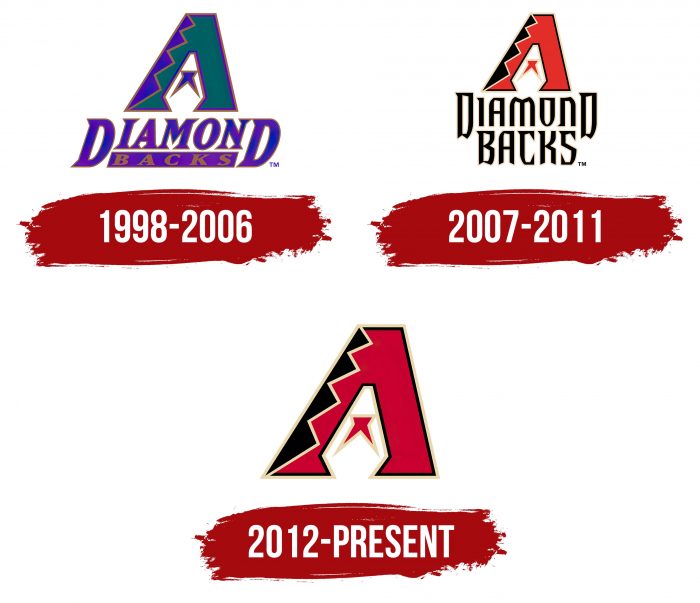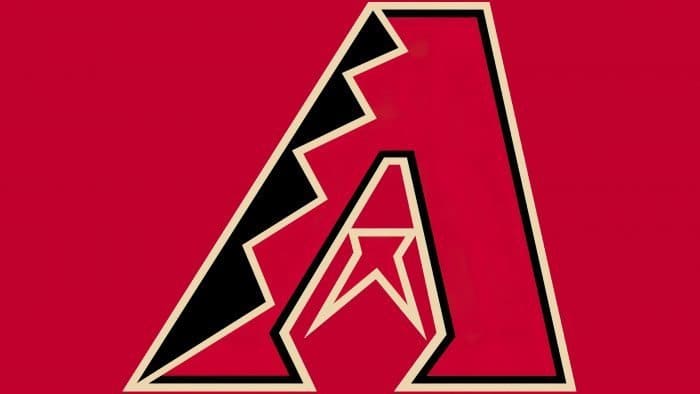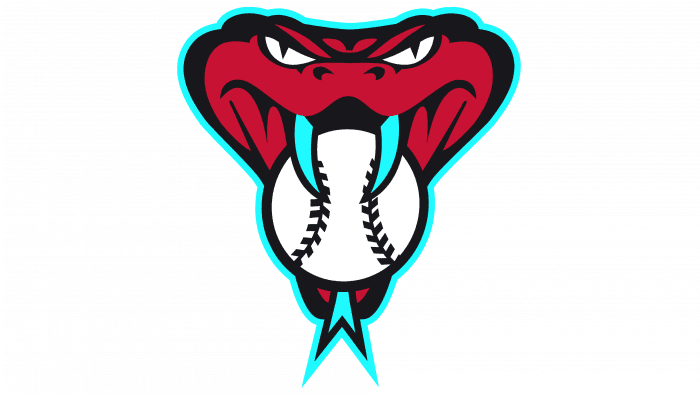The Arizona Diamondbacks logo pays tribute to the sporting heritage of America’s esteemed baseball teams while creating a distinctive mark for the Phoenix club. The logo is minimalist, with the team name and state affiliation taking center stage. It features a stylized depiction of the western diamondback, the team’s mascot, serving as the foundation for the modern Arizona Diamondbacks logo. Beyond its aesthetic appeal, the logo symbolizes the fierce and resilient spirit of the team, drawing inspiration from the perseverance and adaptability of the Diamondback rattlesnake.
Arizona Diamondbacks: Brand overview
The Arizona Diamondbacks’ history started in 1995 when Major League Baseball (MLB) decided to grow the league. The MLB formally declared on March 9, 1995, that Phoenix, Arizona, would get a new expansion team. The rights to form a new baseball franchise were granted to a group of businessmen headed by Jerry Colangelo, who was already the owner of the Phoenix Suns basketball team. There was a $130 million franchise fee. The franchise was officially renamed the “Arizona Diamondbacks” in 1996. The name was selected to honor the native desert-dwelling diamondback rattlesnake of Arizona. The team’s home stadium, Bank One Ballpark (since renamed Chase Field), saw the start of construction that same year.
The team began developing its organizational structure in 1997. Buck Showalter was appointed the first manager. The team signed several free agents to prepare for its inaugural season and actively participated in the rookie draft.
The team took on the Colorado Rockies in their inaugural Major League Baseball game on March 31, 1998. The squad performed admirably for a league rookie, ending with 65 wins and 97 defeats despite losing the opening game. Travis Lee became the first star after winning the National League Rookie of the Year award.
The club saw a tremendous upsurge in 1999, winning 100 games and capturing the NL West division. With this accomplishment, they became the first expansion team in MLB history to win 100 games in a season. Randy Johnson took home his first of four straight Cy Young Awards with the team.
In 2000, the squad maintained its strong play and again won the NL West division. But in the postseason, they fell short against the New York Mets.
2001 will go down in the club’s history. For the third time in four years, the squad won their division. The team advanced to their first World Series by defeating the St. Louis Cardinals and the Atlanta Braves in the playoffs. They defeated the New York Yankees in a thrilling seven-game series to win the MLB championship in just their fourth season of existence. With this accomplishment, they were the first expansion team to win the World Series.
After winning the 2001 World Series, the team went through ups and downs from 2002 to 2006. The squad won the division again in 2002, although they lost in the opening round of the playoffs. The roster was reconstructed, and a fresh development plan was sought for the ensuing years.
The team won the NL West division and returned to the postseason in 2007. They advanced to the National League Championship Series, but the Colorado Rockies defeated them there.
The team’s results were inconsistent between 2008 and 2010. The club kept improving its youth system despite missing out on the playoffs.
The team, which greatly improved from the previous season, unexpectedly won the NL West division in 2011. Kirk Gibson was named National League Manager of the Year.
The club had a phase of rehabilitation from 2012 to 2016. The team failed to make the playoffs even with talents like Paul Goldschmidt.
The team won the National League Wild Card and made a postseason comeback in 2017. However, the division series against the Los Angeles Dodgers fell short.
The squad kept trying to qualify for the playoffs in 2018 and 2019, but they were unsuccessful. This was the start of a new phase of rebuilding the roster.
Due to international events, the 2020 MLB season was truncated, with teams playing 60 games instead of the customary 162, and this brief season presented the club with several obstacles. With 25 wins and 35 losses at the end of the season, the team placed bottom in the NL West division. Both the squad and the supporters were disappointed by this outcome, especially in light of the high hopes following the comparatively successful 2019 campaign.
For the team, 2021 proved to be an even more challenging year. With 110 losses and 52 victories at the end of the season, the squad broke the franchise record for most losses. This was the worst outcome in MLB history and the worst in the team’s history. The club faced several problems, including bad pitching and injuries to important players. The season’s few positive aspects included teenage outfielder Pavin Smith’s impressive performance, which showed promise.
After a disappointing 2021 season, the team started rebuilding in 2022. The group concentrated on identifying new leaders and nurturing youthful talent. The club exceeded even their modest preseason projections, going 74-88 at the end of the season. This was a 22-win increase over the prior campaign. Young talents like pitcher Zac Gallen and outfielder Daulton Varsho were key players of the season. Gallen pitched 44 1/3 shutout innings in a row, setting a franchise record. Fans now have optimism for the team’s future growth because of this season.
The club kept becoming better in 2023. The squad surprised everyone by starting the season well and challenging for a postseason berth. Young athletes such as Corbin Carroll produced excellent outcomes. In the National League Rookie of the Year competition, Carroll, in particular, emerged as a favorite. Many pundits and fans were surprised to find that the club was in the wild card race by the middle of the season. The team’s offensive and defensive performance improved significantly, enabling them to compete with more formidable opponents in the NL West division.
Meaning and History
Before the expansive franchise appeared, the founders asked Phoenix residents to vote for one of the name options. The list included several versions, mainly related to the key symbol of the Arizona-Sonora desert—the rattlesnake. Moreover, a baseball field in America is often called a “diamond.” Thus, Arizona Diamondbacks was born—a play on words with a double meaning. Today, the name is often shortened to D-backs.
The current club’s emblem is an artistic tapestry, beautifully reflecting the symbolism inherent to the club. The logo revolves around an elegantly stylized image of a western diamondback – a snake inhabiting the sands of Arizona. This thoughtful symbol illustrates the deep connection with the club’s geographical roots and emphasizes a sense of regional pride.
Over the years, the club has demonstrated respect for its original design, maintaining the primary elements of the debut logo. Although subtle enhancements and refinements have been made, the essence of the original emblem has remained virtually untouched. Such careful preservation of design elements emphasizes the club’s commitment to its roots and represents a beautiful blend of continuity and evolution.
What is Arizona Diamondbacks?
The Arizona Diamondbacks team represents the Arizona city of Phoenix in professional baseball competitions. It plays at Chase Field, is part of Major League Baseball, and has been a member of the National League West since its foundation in 1998. The franchise’s informal name is D-backs.
1998 – 2006
The original logo of the “Arizona Diamondbacks” was created with deep respect for symbolism and visual narration, weaving the team’s identity into an engaging design narrative. It revolves around a large and bright letter, “A,” thoughtfully stylized to resemble the gaping mouth of a snake. Instead of the usual connecting line in the design, an innovative approach was used: the snake’s tongue was masterfully illustrated, giving the logo a powerful sense of the team’s namesake creature.
Beneath this impressive letter “A,” the team’s full name comfortably sits, executed in two different styles to draw attention to its unique etymology. The word “Diamond,” larger and bolder, was rendered in a deep, rich purple color. This bold color choice attracts attention and gives the design a regal and majestic look, symbolizing the team’s aspiration for perfection and domination.
The word “Backs,” on the other hand, was depicted as if made of sand on a dark purple background. This creative decision is a clear hint at the native sands of Arizona, emphasizing the team’s regional affiliation. This innovative play of textures created a striking visual dichotomy and served as a constant reminder of the team’s connection to its home state.
The central part of the logo, the letter “A,” represented a visual feast executed in a stunning combination of dark green and dark purple colors. This dual color scheme enhanced the overall aesthetics of the logo, giving it sophistication and complexity. Blending these colors served as a visual metaphor for harmony between the team and its environment, strengthening the intertwining of their shared history.
2007 – 2011
In 2007, after eight years, the “Arizona Diamondbacks” decided to conduct a subtle but significant logo evolution. Retaining the distinctive letter “A” reminiscent of the gaping mouth of a snake, they added fresh elements. They updated the color palette to give a new impetus to their brand style.
The symbolic letter “A,” representing the eponymous team and the state of Arizona, retained its original form but transformed in color. From the original palette, the scheme transitioned to bright red and bold black. This bright and striking change evoked intensity, befitting the team’s spirit of rivalry, symbolizing its passion and fiery determination.
The font of the team’s name was transformed. It was set in a different font, giving it a fresh, modern look while retaining the overall essence of the brand. The color also changed from dark purple to a strong, bold black, further emphasizing the brand’s powerful character. To make the name stand out and visually contrast, a thin yellow outline was added to the letters, creating a subtle glow that enhances the overall impact of the logo.
The proportions between the logo elements also underwent a redesign. The iconic letter “A” became more compact, and the team name was enhanced for greater visibility. This adjustment maintained the balance and harmony of the logo, making it more visually appealing and improving readability.
A bright feature of the updated logo was the creative addition of “tails” to the letters “A” and “K” in the word “Backs.” This unique modification resembles the fangs of a snake, further strengthening the team’s association with the Diamondback rattlesnake.
The Arizona Diamondbacks emblem from 2007 to 2011 brilliantly combined tradition and innovation. Carefully thought-out changes in color, typography, and design elements led to creating a more modern, dynamic, and memorable logo that continues to symbolize the team’s unique individuality and energetic spirit.
2012 – today
The current club logo, adorned with simplicity, resonates with minimalist design, demonstrating a departure from its previous, more complex iterations. However, the color palette remains unwaveringly true to its roots, maintaining a unique charm and stunning visual appeal.
Elements synonymous with the state of Arizona are cleverly integrated into the concept. This includes bold Sedona red, reminiscent of the copper actively mined in the state, and evoking images of the breathtaking canyon near Sedona. It is complemented by gentle Sonoran beige – a color that echoes the shade of the sands of the Sonoran Desert. To complete the scheme, black and white colors were harmoniously included, adding depth and contrast to the design. Notably, the previously used turquoise color, symbolizing Arizona’s charming greenish-blue stone, was excluded in this version, aligning with the logo’s pursuit of minimalism.
The emblem revolves around the letter “A” – the main symbol in the team’s and state’s names. This letter is artistically transformed to resemble a rattlesnake – a creature of great significance to the club’s identity. The intricate ornament, mimicking snake skin, and the forked tongue replacing the usual connecting bar in the letter make the snake motif convincing and expressive. The tongue and letter shine with the vibrant force of Sedona red, while the snakeskin pattern is executed in rich black. The light sand border further highlights these features.
Significantly different from previous designs, the logo now increases in size, dominating the space it occupies. The team name, which was constant in previous versions, is deliberately omitted in the design. This change in design strategy emphasizes the stylized letter “A,” allowing the logo to boldly and wordlessly convey the club’s identity. The current logo eloquently embodies the club’s spirit, demonstrating a harmonious combination of local symbolism and modern design principles.
Arizona Diamondbacks: Interesting Facts
The Arizona Diamondbacks, also known as the D-backs, are a baseball team from Phoenix, Arizona. They play in the National League West division of Major League Baseball. They’ve done a lot in a short time.
- Quick Winners: They started in 1998 and won their first World Series in 2001, the fastest a new team has ever done. They beat the New York Yankees, the champions for the last three years.
- Home Field: They play at Chase Field, which used to be called Bank One Ballpark. It has an open-and-closed roof and even a swimming pool for fans.
- Randy Johnson’s Big Game: In 2004, Randy Johnson, a pitcher for the D-backs, played a perfect game, meaning no one got on base. He was 40, making him the oldest to do this.
- Helping Out: The team helps the community through the Arizona Diamondbacks Foundation, which supports people without homes, health care, and kids’ programs.
- Cool Uniforms: In 2016, they showed off new uniforms with different colors and styles.
- Designated Hitter First: In 1998, they were the first National League team to use a designated hitter in a game.
- Fans: Their fans are called the “Snake Pit,” showing how much they love their team.
- Top Pitchers: Some D-backs pitchers have won the Cy Young Award, like Randy Johnson, who won it four times from 1999 to 2002, and Brandon Webb in 2006.
- Worldwide Baseball: The D-backs work to make baseball popular worldwide by playing international games and opening academies in other countries.
The team has done much for baseball in its short history, from winning big games to helping their community and bringing baseball to more people worldwide.
Font and Colors
Throughout its short history, the logo of the Arizona baseball players has hardly changed. The capital letter “A” still resembles a coiled snake ready to strike. The letter represents its body, and the horizontal bar represents a protruding tongue. Therefore, all variants schematically replicate the formidable reptile. Moreover, the official symbol of Arizona is a specific species – the rattlesnake from the viper genus, discovered by herpetologist Frank Willard.
The emblem replicates the pattern on the snake’s body. To do this, artists transferred it to the left side of the sign, forming a graphic ornament from four crest-like protrusions. They are highlighted not only by color but also by a light contour line. The central element is very interesting. It simultaneously resembles two attributes – a forked tongue and sharp fangs.
The inscription on the debut version is executed in italic font. All letters are uppercase and have prominently expressed serifs. Now, an individual font, reminiscent of encrypted symbols, is used. In the first and second versions, the letters “D” in the word “Diamond” are emphasized: the designers enlarged them and made them identical.
The official palette of the emblem is divided into two periods: before 2006 and after. Initially, turquoise-green, blue-violet, and dark sand dominated. The first was used to color the letter, the second for the twisted ornament, and the third for the edging lines.
Then, designers maximally linked the colors to the Arizona desert and included Sedona red #A71930, Sonoran sand #E3D4AD, white #FFFFFF, and black #000000 in the scheme. Additionally, the beige is called the shade of sand from the canyon near Sedona. In honor of it, it received its name – Sonoran Sand. Later, the team added teal color #30CED8.
FAQ
What does the Arizona Diamondbacks logo represent?
At first glance, the Arizona Diamondbacks logo is nothing but the letter A, denoting the team’s name. However, the black triangular ornament on the left side and the angular shape indicate otherwise: the symbol means not just A – it’s an imitation of the western Arizona Diamondback snake, which became the mascot for baseball players. The crossbar reinforces the letter’s resemblance to the reptile in the form of a forked tongue.
When was the Arizona Diamondbacks team founded?
Phoenix received the Major League Baseball franchise in 1995. More precisely, it was done by the group of owners of Arizona Baseball, Inc., led by businessman and sports director Jerry Colangelo. The Arizona Diamondbacks were registered in the league on January 16, 1997, and debuted a few months later, on March 31, 1998.
What colors are “Arizona Diamondbacks”?
After a minor uniform update in 2020, the “Arizona Diamondbacks” chose black, Sonoran sand, and Sedona red as their primary colors. Turquoise is still used, but only in home games. It symbolizes the semi-precious stone mined in Arizona. The white color also remains relevant.
In which city is the Arizona Diamondbacks team located?
The Arizona Diamondbacks are based in Phoenix, the fifth-most populous city in the USA. Phoenix has been the capital of the state of Arizona and its cultural center since 1889.









